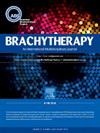Safety and early outcomes of proton therapy and low-dose rate brachytherapy boost for patients with prostate cancer
IF 1.7
4区 医学
Q4 ONCOLOGY
引用次数: 0
Abstract
PURPOSE
Brachytherapy boost improves biochemical control for patients with prostate cancer. Here, we report the safety and early efficacy of proton therapy (PT) with a low-dose-rate (LDR) brachytherapy boost.
METHODS
This retrospective study included patients with intermediate- or high-risk prostate cancer treated with PT followed by LDR boost, with or without androgen deprivation therapy (ADT), from 2010 through 2023. Patient, disease, and treatment characteristics, gastrointestinal (GI) and genitourinary (GU) toxicity, and efficacy outcomes are reported.
RESULTS
Ninety-nine patients received PT and LDR boost; median age at diagnosis was 68 years (interquartile range [IQR] 61–72). Most patients (n = 77) were White, 12 were African American, 5 Asian, and 3 Hispanic. Thirty-five patients had intermediate-risk (4 favorable and 31 unfavorable), 56 had high-risk, and 8 had very high-risk disease. Median PT dose was 44 Gy(RBE) (range 40–50.4) and median LDR dose was 90Gy (range 90–110). Pd-103 seed strands were used for 95 patients and I-125 for 4; 90 had MRI-assisted radiosurgery brachytherapy; 91 received ADT; and 21 had a rectal spacer. At a median follow-up time of 45 months, 5-year biochemical recurrence-free survival was 98%. There was no local recurrence, distant metastasis, or cancer death. Four patients had acute urinary retention after brachytherapy procedure. Eleven patients (11%) had late grade 2 GU toxicity, and 3 (3%) had late grade 2 GI toxicity. One patient had grade 3 urethral stricture requiring dilatation and transurethral resection.
CONCLUSIONS
At 45 months' follow-up time, treatment with PT and LDR boost led to high control rates and low toxicity for men with prostate cancer.
质子治疗和低剂量率近距离治疗对前列腺癌患者的安全性和早期结果有促进作用
目的:近距离放射治疗可改善前列腺癌患者的生化控制。在这里,我们报告了质子治疗(PT)与低剂量率(LDR)近距离治疗的安全性和早期疗效。方法:本回顾性研究纳入了2010年至2023年期间接受PT治疗后LDR增强治疗的中高危前列腺癌患者,同时伴有或不伴有雄激素剥夺治疗(ADT)。报告了患者、疾病和治疗特点、胃肠道(GI)和泌尿生殖系统(GU)毒性和疗效结果。结果99例患者接受了PT和LDR增强治疗;诊断时的中位年龄为68岁(四分位数间距[IQR] 61-72)。大多数患者(n = 77)为白人,12名非裔美国人,5名亚洲人,3名西班牙人。35例为中危(有利4例,不利31例),56例为高危,8例为高危。中位PT剂量为44 Gy(RBE)(范围40-50.4),中位LDR剂量为90Gy(范围90-110)。Pd-103种子股95例,I-125种子股4例;90例行mri辅助放射外科近距离治疗;91人接受ADT;21人有直肠垫片。中位随访时间为45个月,5年生化无复发生存率为98%。没有局部复发、远处转移或癌症死亡。4例患者近距离放射治疗后出现急性尿潴留。11例(11%)患者有2级晚期GU毒性,3例(3%)患者有2级晚期GI毒性。1例患者有3级尿道狭窄,需要扩张和经尿道切除术。结论经45个月随访,前列腺癌患者经PT加LDR治疗控制率高,毒性低。
本文章由计算机程序翻译,如有差异,请以英文原文为准。
求助全文
约1分钟内获得全文
求助全文
来源期刊

Brachytherapy
医学-核医学
CiteScore
3.40
自引率
21.10%
发文量
119
审稿时长
9.1 weeks
期刊介绍:
Brachytherapy is an international and multidisciplinary journal that publishes original peer-reviewed articles and selected reviews on the techniques and clinical applications of interstitial and intracavitary radiation in the management of cancers. Laboratory and experimental research relevant to clinical practice is also included. Related disciplines include medical physics, medical oncology, and radiation oncology and radiology. Brachytherapy publishes technical advances, original articles, reviews, and point/counterpoint on controversial issues. Original articles that address any aspect of brachytherapy are invited. Letters to the Editor-in-Chief are encouraged.
 求助内容:
求助内容: 应助结果提醒方式:
应助结果提醒方式:


